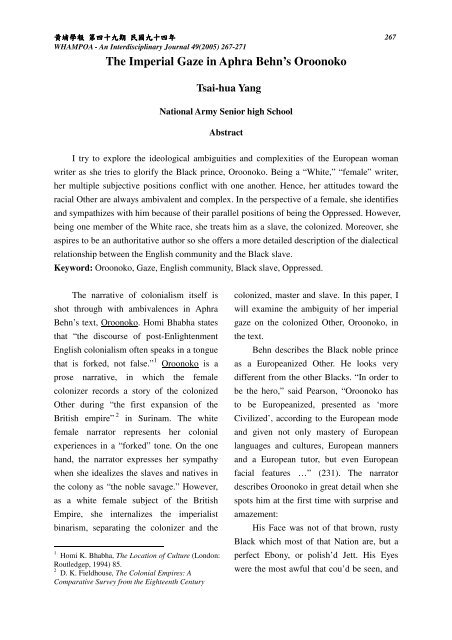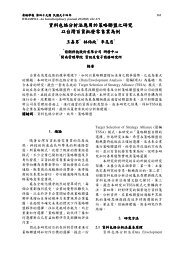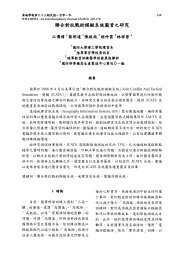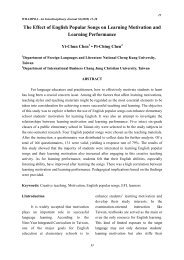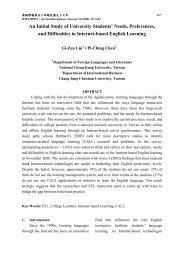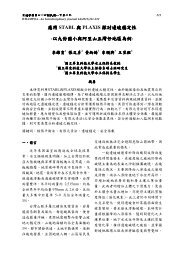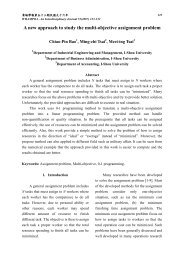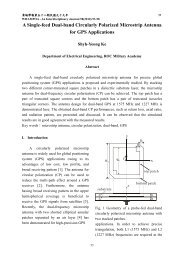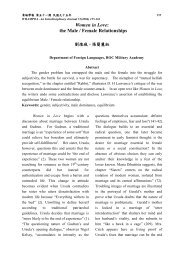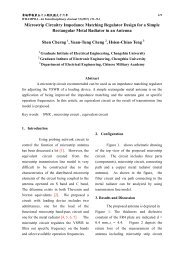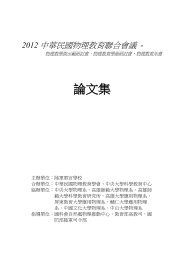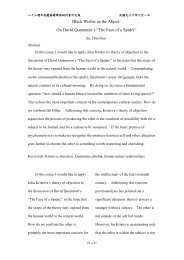The Imperial Gaze in Aphra Behn's Oroonoko
The Imperial Gaze in Aphra Behn's Oroonoko
The Imperial Gaze in Aphra Behn's Oroonoko
Create successful ePaper yourself
Turn your PDF publications into a flip-book with our unique Google optimized e-Paper software.
黃埔學報 埔學報 第四十 第四十九期 第四十<br />
民國九十四年<br />
WHAMPOA - An Interdiscipl<strong>in</strong>ary Journal 49(2005) 267-271<br />
<strong>The</strong> <strong>Imperial</strong> <strong>Gaze</strong> <strong>in</strong> <strong>Aphra</strong> Behn’s <strong>Oroonoko</strong><br />
Tsai-hua Yang<br />
National Army Senior high School<br />
Abstract<br />
I try to explore the ideological ambiguities and complexities of the European woman<br />
writer as she tries to glorify the Black pr<strong>in</strong>ce, <strong>Oroonoko</strong>. Be<strong>in</strong>g a “White,” “female” writer,<br />
her multiple subjective positions conflict with one another. Hence, her attitudes toward the<br />
racial Other are always ambivalent and complex. In the perspective of a female, she identifies<br />
and sympathizes with him because of their parallel positions of be<strong>in</strong>g the Oppressed. However,<br />
be<strong>in</strong>g one member of the White race, she treats him as a slave, the colonized. Moreover, she<br />
aspires to be an authoritative author so she offers a more detailed description of the dialectical<br />
relationship between the English community and the Black slave.<br />
Keyword: <strong>Oroonoko</strong>, <strong>Gaze</strong>, English community, Black slave, Oppressed.<br />
<strong>The</strong> narrative of colonialism itself is<br />
shot through with ambivalences <strong>in</strong> <strong>Aphra</strong><br />
Behn’s text, <strong>Oroonoko</strong>. Homi Bhabha states<br />
that “the discourse of post-Enlightenment<br />
English colonialism often speaks <strong>in</strong> a tongue<br />
that is forked, not false.” 1 <strong>Oroonoko</strong> is a<br />
prose narrative, <strong>in</strong> which the female<br />
colonizer records a story of the colonized<br />
Other dur<strong>in</strong>g “the first expansion of the<br />
British empire” 2 <strong>in</strong> Sur<strong>in</strong>am. <strong>The</strong> white<br />
female narrator represents her colonial<br />
experiences <strong>in</strong> a “forked” tone. On the one<br />
hand, the narrator expresses her sympathy<br />
when she idealizes the slaves and natives <strong>in</strong><br />
the colony as “the noble savage.” However,<br />
as a white female subject of the British<br />
Empire, she <strong>in</strong>ternalizes the imperialist<br />
b<strong>in</strong>arism, separat<strong>in</strong>g the colonizer and the<br />
1<br />
Homi K. Bhabha, <strong>The</strong> Location of Culture (London:<br />
Routledgep, 1994) 85.<br />
2<br />
D. K. Fieldhouse, <strong>The</strong> Colonial Empires: A<br />
Comparative Survey from the Eighteenth Century<br />
267<br />
colonized, master and slave. In this paper, I<br />
will exam<strong>in</strong>e the ambiguity of her imperial<br />
gaze on the colonized Other, <strong>Oroonoko</strong>, <strong>in</strong><br />
the text.<br />
Behn describes the Black noble pr<strong>in</strong>ce<br />
as a Europeanized Other. He looks very<br />
different from the other Blacks. “In order to<br />
be the hero,” said Pearson, “<strong>Oroonoko</strong> has<br />
to be Europeanized, presented as ‘more<br />
Civilized’, accord<strong>in</strong>g to the European mode<br />
and given not only mastery of European<br />
languages and cultures, European manners<br />
and a European tutor, but even European<br />
facial features …” (231). <strong>The</strong> narrator<br />
describes <strong>Oroonoko</strong> <strong>in</strong> great detail when she<br />
spots him at the first time with surprise and<br />
amazement:<br />
His Face was not of that brown, rusty<br />
Black which most of that Nation are, but a<br />
perfect Ebony, or polish’d Jett. His Eyes<br />
were the most awful that cou’d be seen, and
268 黃埔學報 埔學報 埔學報 第四十 第四十九期 第四十 民國九十四年<br />
very pierc<strong>in</strong>g, the White of ‘em be<strong>in</strong>g like<br />
Snow, as were his Teeth. His Nose was<br />
ris<strong>in</strong>g and Roman, <strong>in</strong>stead of African and<br />
flat. His Mouth, the f<strong>in</strong>est shap’d that cou’d<br />
be seen; far from those great turn’d Lips,<br />
which are so natural to the rest of the<br />
Negroes. <strong>The</strong> whole Proportion and Air of<br />
his Face was so noble, and exactly form’d,<br />
that, bat<strong>in</strong>g his Colour, there cou’d be<br />
noth<strong>in</strong>g <strong>in</strong> Nature more beautiful, agreeable<br />
and handsome. <strong>The</strong>re was no one Grace<br />
want<strong>in</strong>g, that bears the Standard of true<br />
Beauty. (13-14)<br />
Behn beautifies him to become a noble<br />
European. He has Western features: pierc<strong>in</strong>g<br />
eyes, white teeth, ris<strong>in</strong>g nose, and a<br />
f<strong>in</strong>e-shaped mouth. On the other hand, his<br />
Europeanized looks are sharply different<br />
from the other Negroes. At first, Behn<br />
dist<strong>in</strong>guishes <strong>Oroonoko</strong> from other natives<br />
by his sk<strong>in</strong>. His sk<strong>in</strong> is brightly black, like<br />
“a perfect Ebony”, or “polished Jett” but<br />
other people’s is “rusty black”. His mouth,<br />
“the f<strong>in</strong>est shap’d” does not have “the great<br />
turn’d Lips” as those other Negroes. His<br />
features are so similar with the Europeans’<br />
that we almost identify him as a European<br />
aristocrat, not a Negro, or a savage. In this<br />
way, Behn tries to erase <strong>Oroonoko</strong>’s racial<br />
dist<strong>in</strong>ction by his Europeanized appearance.<br />
Even though Behn idealizes <strong>Oroonoko</strong><br />
as a” Noble Savage,” her attitude toward this<br />
racial Other is still ambivalent. This<br />
ambivalence is shown at the moment when<br />
the White female narrator observes<br />
<strong>Oroonoko</strong>’s physical features, educational<br />
background, and social class. In the text, we<br />
f<strong>in</strong>d both Behn’s desire to serve the purposes<br />
of empire and an effort to put a stop to it. It<br />
is also difficult to detach the female narrator,<br />
who has sympathy for the oppressed Black<br />
pr<strong>in</strong>ce, from the White colonizer, who<br />
oppresses <strong>Oroonoko</strong> to serve the <strong>in</strong>terests of<br />
colonial capitalism. As a White female<br />
writer, Behn has split perspectives <strong>in</strong><br />
observ<strong>in</strong>g the Black subject, <strong>Oroonoko</strong>. She<br />
portrays the nobility of <strong>Oroonoko</strong>. However,<br />
she also shows a strong ambivalence for this<br />
Black pr<strong>in</strong>ce when she idealizes him.<br />
Behn’s portrait of <strong>Oroonoko</strong>’s physical<br />
features reveals her dichotomous<br />
representation of the colonized. Accord<strong>in</strong>g<br />
to Firdous Azim, “<strong>Oroonoko</strong>’s racial<br />
characteristics and features follow a long<br />
l<strong>in</strong>e of tradition of the del<strong>in</strong>eation of the<br />
Black man <strong>in</strong> English literature. <strong>The</strong> racially<br />
ambivalent or mixed person, such as the<br />
Moor, is preferred. (49)” Based on the<br />
tradition, his physical appearance is different<br />
form other Blacks and suitably<br />
Europeanized. His Europeanized features<br />
not only easily <strong>in</strong>tegrated him <strong>in</strong>to the White<br />
society but also serve the European<br />
readership. On the other hand, <strong>Oroonoko</strong>’s<br />
Europeanization is a “reductive<br />
normaliz<strong>in</strong>g” accord<strong>in</strong>g to Mary Louise<br />
Pratt 3 . Laura Brown also agrees with this<br />
po<strong>in</strong>t that it is a process of familiarization to<br />
“mediate the shock of contact 4 ” <strong>in</strong> the first<br />
encounter of the racial Other. Through the<br />
“reductive normaliz<strong>in</strong>g,” the familiarized<br />
racial Other is fixed and codified <strong>in</strong> the<br />
framework of the European system.<br />
When Behn characterizes <strong>Oroonoko</strong>,<br />
3 Mary Louise Pratt, “Scratches on the Face of the<br />
Country; or, What Mr. Barrow Saw <strong>in</strong> the Land of the<br />
Bushmen,” Critical Inquiry 12(1985):121.<br />
4 Laura Brown, Ends of Empire (New York: Cornell<br />
University, 1993) 39.
Tsai-hua Yang: <strong>The</strong> <strong>Imperial</strong> <strong>Gaze</strong> <strong>in</strong> <strong>Aphra</strong> Behn’s <strong>Oroonoko</strong> 269<br />
she attempts to familiarize him. However,<br />
the unsuccessful part such as his black sk<strong>in</strong><br />
becomes far more visible <strong>in</strong>stead. “In Looks<br />
That Kill: Violence and Representation <strong>in</strong><br />
<strong>Aphra</strong> Behn’s <strong>Oroonoko</strong>,” Anne Fogarty<br />
remarks that “the more she (Behn)<br />
endeavours to erase <strong>Oroonoko</strong>’s difference,<br />
the more prom<strong>in</strong>ent it becomes. (12)” In<br />
spite of his Europeanized appearance, she<br />
does not wipe out his black ethnic identity.<br />
Moreover, his complexion is extremely<br />
black, like “perfect ebony” or “polished jet”<br />
(13). It is impossible for <strong>Oroonoko</strong> to<br />
remove his alterity completely. As a result,<br />
neither a Negro nor a White man, he<br />
becomes a racially ambivalent or mixed<br />
person. He is described as someone very<br />
familiar and attractive but also strange and<br />
exotic. Behn’s imperfect Europeanization of<br />
<strong>Oroonoko</strong> predicts the impossible unity<br />
between the Black pr<strong>in</strong>ce and his White<br />
female friend with<strong>in</strong> the framework of the<br />
colonial system. Furthermore, <strong>Oroonoko</strong>’s<br />
<strong>in</strong>effaceable sk<strong>in</strong> color becomes a locus of<br />
their separateness.<br />
I th<strong>in</strong>k that <strong>Oroonoko</strong>’s blackness is of<br />
double mean<strong>in</strong>gs. I do not deny that his<br />
blackness represents his racial difference<br />
from the Western narrator and causes their<br />
division. However, I do believe that his sk<strong>in</strong><br />
color also rem<strong>in</strong>ds the female narrator of his<br />
oppression and causes her sympathy for the<br />
anti-slavery discourse <strong>in</strong> the Eighteenth<br />
century. <strong>The</strong> racial difference, symbolized<br />
by black sk<strong>in</strong>, paradoxically generates split<br />
and fusion, discrim<strong>in</strong>ation and sympathy<br />
between the Black and White races.<br />
<strong>Oroonoko</strong>’s blackness rem<strong>in</strong>ds the White<br />
female simultaneously of their difference<br />
and comradeship. It also arouses both her<br />
love and hate for the Black Other at the<br />
same time.<br />
Behn does want to br<strong>in</strong>g about the<br />
fusion of the Black and White race, so she<br />
tries to break the traditional opposition<br />
between “us” Europeans and “them”<br />
non-Europeans. However, this<br />
Europeanization of his physical beauty by<br />
Behn also exhibits her Eurocentric cultural<br />
supremacy. <strong>Oroonoko</strong>, as Jacquel<strong>in</strong>e<br />
Pearson po<strong>in</strong>ts out, <strong>in</strong> order to be the hero,<br />
has to be Europeanized accord<strong>in</strong>g to “the<br />
European Mode” (30). This could be<br />
regarded as a reduction of <strong>Oroonoko</strong>’s<br />
Otherness by the Eurocentric aesthetic<br />
standards. <strong>The</strong> so-called “cultural<br />
hegemony” accord<strong>in</strong>g to Antonio Gramsci is<br />
clearly at work especially when <strong>Oroonoko</strong> is<br />
depicted as a Europeanized pr<strong>in</strong>ce. For the<br />
racist bias is never denied by Behn that the<br />
idea of European identity is a superior one <strong>in</strong><br />
comparison with all the non-European<br />
peoples and cultures 5 .<br />
Behn <strong>in</strong>troduces <strong>Oroonoko</strong>’s physical<br />
beauty <strong>in</strong> anthropological details, as if the<br />
Black pr<strong>in</strong>ce is transformed <strong>in</strong>to the “object”<br />
of the Western gaze. He is at first under the<br />
narrative gaze of the dom<strong>in</strong>ant White female,<br />
and then brought under the gaze of<br />
European readers. This objectification is<br />
also a part of a process of fem<strong>in</strong>ization and<br />
sexualization because he is like an actress<br />
putted on the centre-stage and fetishised for<br />
corporeal display. In addition, as one of the<br />
slaves <strong>in</strong> the capital and commercial colony,<br />
5 Edward W. Said, Orientalism (New York: A<br />
Division of Random House, 1978) 7.
270 黃埔學報 埔學報 埔學報 第四十 第四十九期 第四十 民國九十四年<br />
<strong>Oroonoko</strong> is turned <strong>in</strong>to the colonizer’s<br />
property for the economical market. This<br />
read<strong>in</strong>g enables a parallelism between the<br />
Black race and the oppressed women. As M.<br />
Duffy said, “<strong>The</strong> slaves have become<br />
property, as women purchased <strong>in</strong> the<br />
marriage market were property.” 6 Although<br />
the female narrator and <strong>Oroonoko</strong> were<br />
members of the similarly subjugated group<br />
<strong>in</strong> the patriarchal society, the female<br />
colonizer nevertheless uses the fetishiz<strong>in</strong>g<br />
language of the colonizer <strong>in</strong> order to<br />
sexualize <strong>Oroonoko</strong>.<br />
Behn idealizes <strong>Oroonoko</strong> as a “royal”<br />
slave because of his high social status as a<br />
pr<strong>in</strong>ce. This noblization is an ambiguous<br />
process of idealization and fetishization<br />
shown <strong>in</strong> the way Behn characterizes<br />
<strong>Oroonoko</strong>. It, however, cannot change his<br />
actual situation of be<strong>in</strong>g a slave <strong>in</strong> the<br />
colony. On the contrary, it makes <strong>Oroonoko</strong><br />
not just a commodity, but a “fetished”<br />
commodity <strong>in</strong> the colonial slave economy.<br />
<strong>Oroonoko</strong> is commodified because he<br />
becomes a slave to be traded by the<br />
colonizers. On the other hand, he is not<br />
taken as a labourer as other slaves. He is<br />
fetishised accord<strong>in</strong>g to his “exchange value”,<br />
not his “use value” 7 because “he suffered<br />
only the Name of the Slave, and had noth<strong>in</strong>g<br />
of the Toil and Labour of one” (42). It does<br />
not matter that he is not useful for his White<br />
master. After all he becomes a fetish, the<br />
object of the colonizer’s desire.<br />
<strong>The</strong> colonial gaze on the Other is<br />
6 <strong>The</strong> Passionate Shepherdess: <strong>Aphra</strong> Behn, 1640-89,<br />
London, Jonathan Cape, 1977, p268.<br />
7 For Marx, a “commodity” is judged not accord<strong>in</strong>g<br />
to their “use value” but accord<strong>in</strong>g to their “exchange<br />
value”.<br />
always dubious and vague, no matter what<br />
social rank the Other comes from. <strong>Oroonoko</strong><br />
is sold as a slave to Trefry, who f<strong>in</strong>ds out his<br />
royal bear<strong>in</strong>g from “someth<strong>in</strong>g so<br />
extraord<strong>in</strong>ary <strong>in</strong> his Face, his Shape and<br />
Mien, a Greatness of Look, and Haught<strong>in</strong>ess<br />
<strong>in</strong> his Air” (35). <strong>Oroonoko</strong>’s class difference<br />
from other slaves results <strong>in</strong> the brotherhood<br />
and friendship between him and the Western<br />
masters but the truth is, he is noth<strong>in</strong>g but a<br />
slave, albeit a “royal” slave. <strong>The</strong><br />
master-slave relationship is obvious <strong>in</strong> the<br />
text when Trefry renames <strong>Oroonoko</strong> as<br />
“Caesar”. Although Behn expla<strong>in</strong>s that the<br />
Westerners give the natives new names<br />
because their native ones are hard to<br />
pronounce. In fact, the act of nam<strong>in</strong>g is<br />
related to a declaration of possession. <strong>The</strong><br />
new name signifies <strong>Oroonoko</strong>’s new identity<br />
as a slave <strong>in</strong> the colony. As a result, Behn<br />
writes that “by that name he was receiv’d on<br />
Shore at Parham-House, where he was<br />
dest<strong>in</strong>’d a Slave” (37). <strong>The</strong>refore, the new<br />
name “Caesar” symbolizes their relationship<br />
of master and slave <strong>in</strong> the colonial empire<br />
although they show love and esteem to each<br />
other.<br />
In the very beg<strong>in</strong>n<strong>in</strong>g, <strong>Oroonoko</strong> is<br />
idealized as a noble pr<strong>in</strong>ce, who not only has<br />
classical European beauty and m<strong>in</strong>d but also<br />
can build a brotherhood with the White<br />
people. As I have discussed <strong>in</strong> Chapter One,<br />
the sentimental identification proves Behn’s<br />
sympathy for the oppressed. However, the<br />
racial and ethnical difference never can be<br />
effaced under the colonial gaze throughout<br />
the whole story. He cannot avoid be<strong>in</strong>g<br />
identified with a black slave <strong>in</strong> the system of<br />
imperial society. Behn’s narration about her
Tsai-hua Yang: <strong>The</strong> <strong>Imperial</strong> <strong>Gaze</strong> <strong>in</strong> <strong>Aphra</strong> Behn’s <strong>Oroonoko</strong> 271<br />
Black hero is always so ambiguous that we<br />
cannot tell whether <strong>Oroonoko</strong> is a friend or<br />
an enemy, a pr<strong>in</strong>ce or a slave <strong>in</strong> Behn’s<br />
op<strong>in</strong>ion. (Summariz<strong>in</strong>g from my thesis for<br />
the Master Degree)<br />
References<br />
[1] Homi K. Bhabha, <strong>The</strong> Location of<br />
Culture (London: Routledgep, 1994)<br />
85.<br />
[2] D. K. Fieldhouse, <strong>The</strong> Colonial<br />
Empires: A Comparative Survey from<br />
the Eighteenth Century<br />
[3] Mary Louise Pratt, “Scratches on the<br />
殖民者的角度凝視被殖民者<br />
殖民者的角度凝視被殖民者<br />
殖民者的角度凝視被殖民者<br />
楊采樺<br />
楊采樺<br />
陸軍高中 陸軍高中<br />
陸軍高中<br />
摘要<br />
摘要<br />
Face of the Country; or, What Mr.<br />
Barrow Saw <strong>in</strong> the Land of the<br />
Bushmen,” Critical Inquiry<br />
12(1985):121.<br />
[4] Laura Brown, Ends of Empire (New<br />
York: Cornell University, 1993) 39.<br />
[5] Edward W. Said, Orientalism (New<br />
York: A Division of Random House,<br />
1978) 7.<br />
[6] <strong>The</strong> Passionate Shepherdess: <strong>Aphra</strong><br />
Behn, 1640-89, London, Jonathan Cape,<br />
1977, p268.<br />
[7] For Marx, a “commodity” is judged not<br />
accord<strong>in</strong>g to their “use value” but<br />
accord<strong>in</strong>g to their “exchange value”.<br />
本文主要探討班如何以殖民者的角度凝視 (<strong>Gaze</strong>)被殖民者。從一個殖民者的角度看<br />
被殖民者,她的態度搖擺不定,徘徊在肯定及否定被殖民者之間。當一位歐洲女性作家<br />
試圖刻劃黑人王子歐魯諾克的故事時,在意識型態上所面對的矛盾弔詭之處。身為一個”<br />
白人”,”女性”作家,艾芙拉,班的主體意識位置 (subjective positions)多重而複雜且互<br />
相衝突,因此,她對這位異族他者的態度總是曖昧不明。從一個女性的角度來看,同樣<br />
身為社會中的受迫者,班認同且同情歐魯諾克,將之盛讚為一位外貌俊美挺拔之黑人王<br />
子。但是,身為白人社會的一份子,她仍視他為黑奴,是一個被殖民者。<br />
關鍵字:凝視,被殖民者,主體意識位置,歐魯諾克。
272 黃埔學報 埔學報 埔學報 第四十 第四十九期 第四十 民國九十四年


